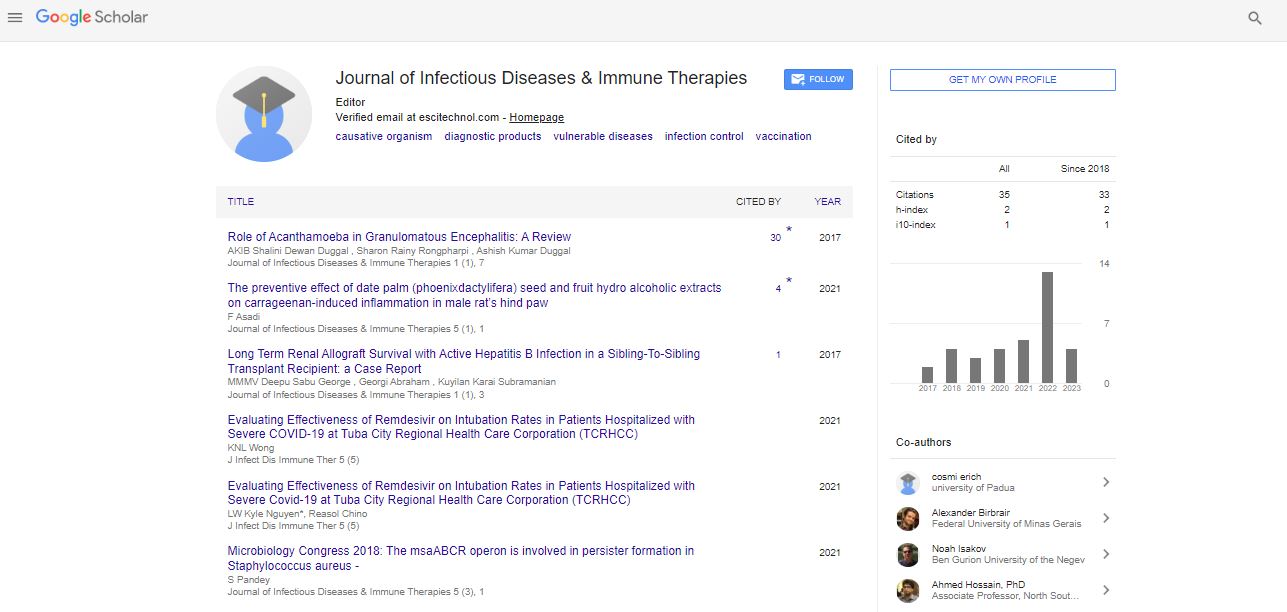Perspective, J Infect Dis Immune Ther Vol: 7 Issue: 1
Streptococcus: From Commensals to Pathogens–Insights to Clinical Microbiology
Kressel Grayson*
Department of Molecular Microbiology, School of Life Sciences, University of Dundee, Dundee, United Kingdom
*Corresponding Author: Kressel Grayson
Department of Molecular Microbiology, School of Life Sciences, University of Dundee, Dundee, United Kingdom
E-mail: kressgray@dundee.ac.uk
Received date: 03 February, 2023, Manuscript No. JIDITH-23-96357;
Editor assigned date: 07 February, 2023, PreQC No. JIDITH-23-96357 (PQ);
Reviewed date: 21 February, 2023, QC No. JIDITH-23-96357;
Revised date: 28 February, 2023, Manuscript No. JIDITH-23-96357 (R);
Published date: 07 March, 2023, DOI: 10.4172/JIDITH.1000156
Citation: Grayson K (2023) Streptococcus: From Commensals to Pathogens–Insights to Clinical Microbiology. J Infect Dis Immune Ther 7:1.
Description
Streptococcus is a Gram-positive bacterial genus that encompasses a wide range of species, some of which are commonly found in the human microbiota as commensals, while others are notorious pathogens responsible for a variety of infections. Streptococcus infections can range from mild to severe, and they pose significant clinical challenges due to their diverse manifestations, antibiotic resistance, and potential for complications.
Clinical significance of streptococcus
Streptococcus species are implicated in a wide array of human infections, ranging from mild to life-threatening. Streptococcal pharyngitis, commonly known as strep throat, is one of the most common bacterial infections caused by Streptococcus pyogenes. Other streptococcal infections include skin and soft tissue infections, pneumonia, endocarditis, meningitis, and sepsis. Streptococcus agalactiae, also known as Group B Streptococcus (GBS), is a leading cause of neonatal sepsis and meningitis. Additionally, Streptococcus pneumoniae is a major cause of bacterial pneumonia, sinusitis, and otitis media.
Pathogenicity of streptococcus
The pathogenicity of Streptococcus is multifactorial and involves various virulence factors that enable the bacteria to evade host immune defenses and cause disease. Streptococci possess various adhesins, toxins, enzymes, and capsules that facilitate colonization, tissue invasion, and immune evasion. For example, Streptococcus pyogenes produces streptolysin O and streptolysin S, which are hemolytic toxins that can damage host tissues and suppress the immune response. Streptococcus pneumoniae produces a polysaccharide capsule that aids in immune evasion and allows the bacteria to colonize and cause infections in various body sites.
Diagnosis and treatment of streptococcus infections
The diagnosis of Streptococcus infections relies on clinical evaluation, along with microbiological testing, including culture and molecular methods. Rapid Antigen Detection Tests (RADTs) are commonly used for the diagnosis of streptococcal pharyngitis, while blood cultures are essential for the diagnosis of invasive infections. Susceptibility testing is important to guide appropriate antibiotic therapy, as some Streptococcus species have developed resistance to commonly used antibiotics. Penicillin and amoxicillin are the first-line antibiotics for treating streptococcal pharyngitis, while other infections may require different antibiotics, such as macrolides, cephalosporins, or vancomycin, depending on the species, severity, and antibiotic resistance patterns.
Emerging trends in streptococcus analysis
Analysis on Streptococcus is continuously evolving, and several emerging trends are shaping our understanding of the genus. One such trend is the increasing awareness of the role of Streptococcus as a commensal in the human microbiota and its potential impact on health and disease. Additionally, there is growing interest in studying the molecular mechanisms of streptococcal virulence, antibiotic resistance, and host-pathogen interactions to develop novel therapeutics and vaccines. The use of molecular techniques, such as whole-genome sequencing and transcriptomics, has enabled in-depth characterization of streptococcal genomes and gene expression profiles, providing insights into their pathogenicity and evolutionary dynamics.
Conclusion
Streptococcus is a diverse genus of bacteria with both commensal and pathogenic species that have significant clinical relevance. Streptococcus infections can range from mild to severe, affecting various body sites and presenting challenges in diagnosis and treatment due to antibiotic resistance. The pathogenicity of Streptococcus involves a complex interplay of virulence factors that facilitate colonization, tissue invasion, and immune evasion. Diagnosis relies on clinical evaluation and microbiological testing, while treatment requires appropriate antibiotic therapy based on species identification and susceptibility testing.
 Spanish
Spanish  Chinese
Chinese  Russian
Russian  German
German  French
French  Japanese
Japanese  Portuguese
Portuguese  Hindi
Hindi 